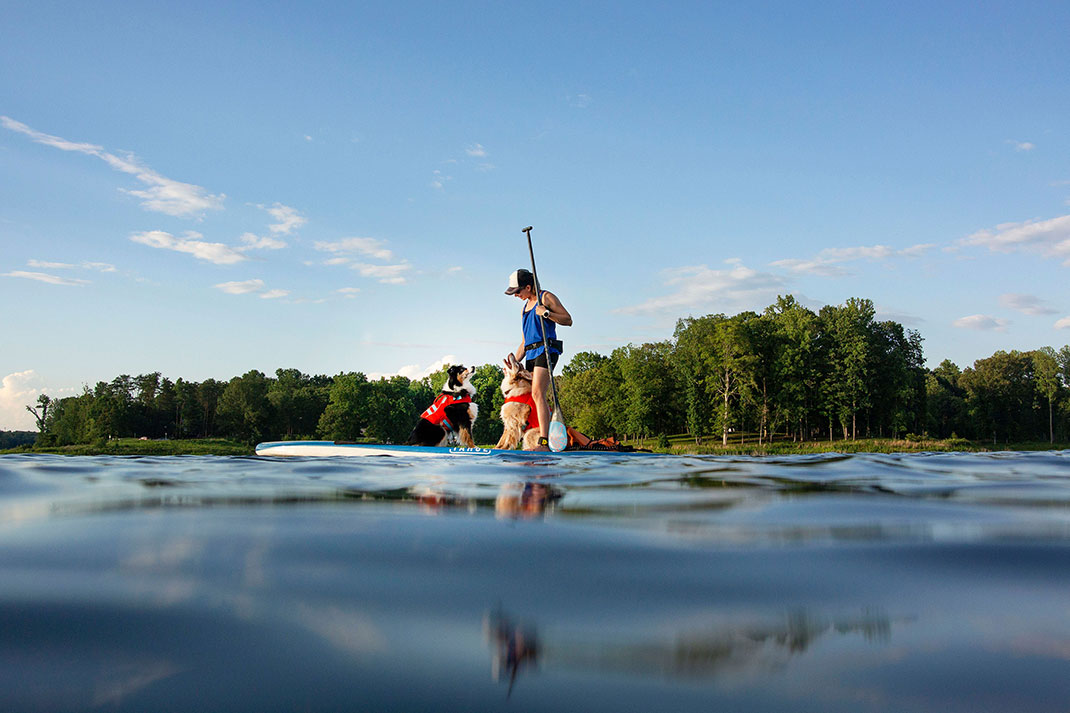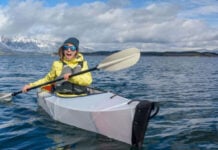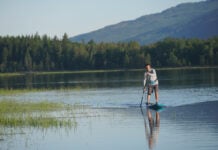Learning how to standup paddleboard with your dog can seem daunting, but it’s easier than you might think. Many dogs pick up the sport as quickly as their humans. The trick is making the learning process fun while keeping safety in mind. This means having the right gear, being a confident paddleboarder so you can inspire confidence in your pooch, and training your dog to understand the board is a place to chill out and let you do all the work. Master that and you’ll be well on your way to creating an even stronger bond with your pup.
Here’s what you need to know to get started paddleboarding with a dog.
Best paddleboards for dogs
Having an appropriately sized board is one of the most significant factors in making you and your dog feel comfortable on the water. Add your body weight plus your dog’s to make sure the board in question has an appropriate capacity and volume to accommodate your dynamic duo. A chihuahua won’t make any difference, but a golden retriever or German shepherd on board might mean you need to size up. A wider board will also provide more stability; look for something in the 30- to 34-inch range.
Dog on inflatable paddleboard
Inflatable paddleboards are a dog-friendly choice. The rubber surface helps your pup’s pads grip the board. If your pup makes an unexpected wet exit, the material of the inflatable board is durable and offers some traction for scrabbling reentries. Wondering, “will my dog pop an inflatable paddleboard?” Don’t worry about your pup’s nails puncturing the board—the material is way tougher than that.
Dogs on hard paddleboards
Hard boards are okay for pets too. Aim for a full-length deck pad to ensure your pup has grip—they’ll feel more comfortable with traction underfoot and will be less likely to slide off too.
Dog life jackets for paddleboarding
Both you and your dog should always wear life jackets while on the water. Most dog life jackets have a handy suitcase-style handle on the back to aid in heaving your dog back on the board if he falls off. The life jacket also increases visibility in the water and, of course, keeps your pup afloat if he gets tired.
How to teach your dog to standup paddleboard
To help Fido understand the board is a safe place to sit and stay put, follow these steps to introduce your pup to your paddleboard.
How to get your dog on a paddleboard
First, place the board in a familiar and safe environment, like the backyard or living room, for your dog to investigate. After allowing your pup to sniff it, lure your dog onto the deck of the board with a treat. When your dog has all four paws on the board, mark the good behavior with verbal praise and reward with a tasty treat.
Next, ask for behaviors like sit and down on the board and reward. Work on sit stays and down stays on the board, gradually increasing the duration of the stay. Work on a release command, like “Okay!” to give your dog permission to exit the board.
Once your dog is reliably staying on the board, introduce the life jacket, and repeat practicing sit and down stays while wearing the life jacket. Once the dog is again comfortable, introduce the paddle. Make sure your dog is comfortable with the paddle moving around him while on the board maintaining a stay. Then stand on the board next to the dog. Be patient, this process could take days.
Once you’ve introduced the board, PFD and paddle, take your board to the water. Choose a glassy day. Don’t expect to go far or fast on the first outing. Even just sitting together out on the water is an excellent first excursion.
Keep training fun and your training sessions short and sweet, with tons of praise, treats and positive reinforcement. Gradually introduce longer duration when your dog is comfortable. Ensure they’re having fun before trying longer excursions. And keep rewarding the pup for their good behavior to create positive associations.

Five more pro tips for success
These are my top five tips to make paddleboarding with your dog safe and enjoyable.
1 Be confident
When you paddle with your furry friend, they’re looking to you for guidance and confidence. If you’re anxious, they’ll pick up on that. To make your pup feel safe, you need to be comfortable on the board and a competent paddler.
2
Stay within comfort levels
The more wind, current and the larger Fido is, the harder you will have to work. Know the forecast, keep an eye on conditions and always err on the side of caution, staying within your paddling limits. Also, keep an eye on your dog’s comfort level—remember, dogs may not understand the so-called fun of epic mileage or miserable weather.
3
Always wear your leash
When a dog jumps off, it can knock you off too and cause the board to travel. If it’s a windy day, the board will get away from you quickly. A leash is key to keeping your board close in an upset, but is only recommended for flatwater environments. Coiled leashes are best for flatwater, so it won’t hang off the sides of the board and get caught on objects in the water. Make sure your dog has mastered staying on the board before attempting to paddle waterways with a current.
4
Your dog’s leash is optional
A well-trained dog shouldn’t need a leash while on a paddleboard. If you take the time to help your dog understand the board is a place to sit and stay on until released, you should be fine leash-free. However, if your pup is not reliable, you may feel safer leashing your dog and I recommend a short, four-foot leash attached to the dog’s life jacket, not the collar. Never tie your dog to the paddleboard and never leash your dog in current.
5
Make a swim plan
Know what to do when you fall off the board. First, recover the board—easy if you’re wearing a leash—then the dog and any other gear. If your dog likes to swim, you can practice self-rescuing together under controlled circumstances with lots of rewards, so it’s not a scary experience when it happens for real.
This article was first published in Paddling Magazine Issue 64. Subscribe to Paddling Magazine’s print and digital editions here, or download the Paddling Magazine app and browse the digital archives here.
Maria Christina Schultz is a standup paddleboard instructor and author of How To SUP With Your Pup. She lives in Virginia with her three Australian shepherds.
Making memories that will last fur-ever. | Photo: Courtesy Maria Christina Schultz









